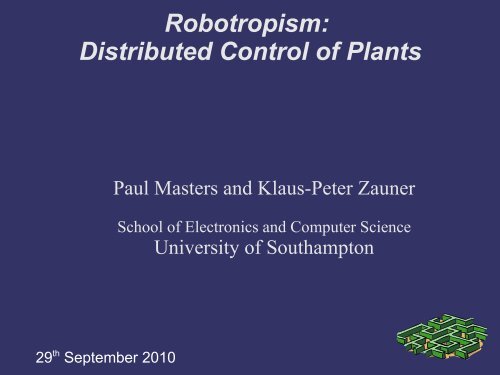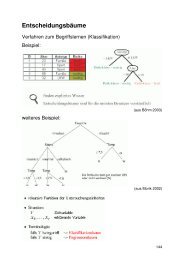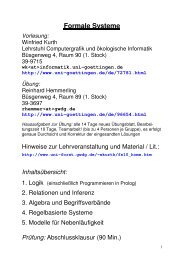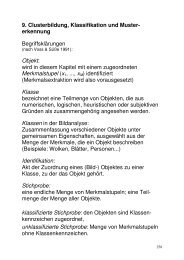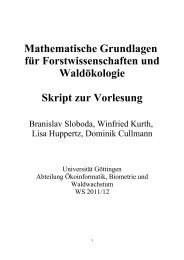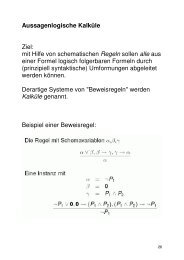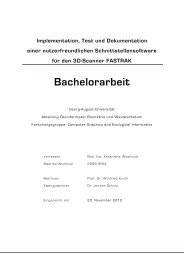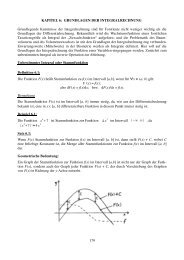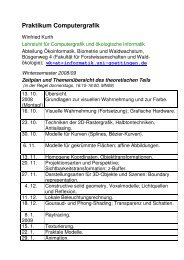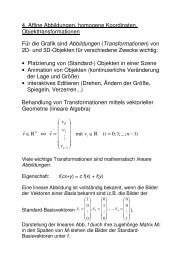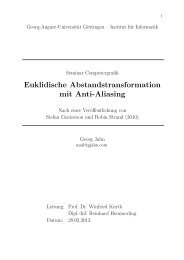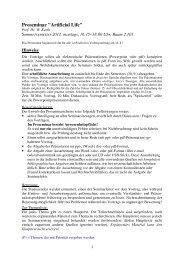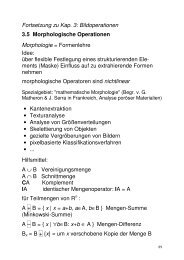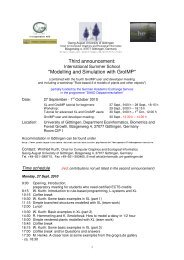Robotropism: Distributed Control of CLimbing Plants
Robotropism: Distributed Control of CLimbing Plants
Robotropism: Distributed Control of CLimbing Plants
Create successful ePaper yourself
Turn your PDF publications into a flip-book with our unique Google optimized e-Paper software.
<strong>Robotropism</strong>:<br />
<strong>Distributed</strong> <strong>Control</strong> <strong>of</strong> <strong>Plants</strong><br />
Paul Masters and Klaus-Peter Zauner<br />
School <strong>of</strong> Electronics and Computer Science<br />
University <strong>of</strong> Southampton<br />
29 th September 2010
Overview<br />
➲ Motivation<br />
➲ What is <strong>Robotropism</strong>?<br />
➲ Aims<br />
➲ Agent Classification<br />
➲ Implementation<br />
●<br />
●<br />
Physics Engine<br />
Tropisms and <strong>Control</strong>ler Agents<br />
➲ Structural Tests<br />
➲ Conclusions
Motivation<br />
[1]<br />
[2]<br />
[3]
What is <strong>Robotropism</strong>?<br />
<strong>Control</strong> <strong>of</strong> the spatial shape <strong>of</strong> plants through<br />
small artificial controllers attached to the plants<br />
Here:<br />
➲ Exploits thigmotropism <strong>of</strong> plants<br />
➲ Touch stimulates growth in desired direction<br />
➲ A slow robot:<br />
●<br />
●<br />
Electronic Brain<br />
Plant body
Aims<br />
➲ Simulate Climbing <strong>Plants</strong><br />
➲ Gravity using a physics engine<br />
➲ Phototropism etc. using GroIMP<br />
➲ Robotriopism – controlling agents<br />
➲ Explore the possibilities <strong>of</strong> growing<br />
structures to order.
Agent Classification<br />
➲ Level 0 – No Spatial Awareness<br />
●<br />
●<br />
Passive, wind or solar powered<br />
Fixed relative direction<br />
➲ Level 1 – Relative Spatial Awareness<br />
●<br />
●<br />
Microcontroller based<br />
Follow a beacon. Light, Sound, Radio<br />
➲ Level 2 – Absolute Spatial Awareness<br />
●<br />
●<br />
Knows position <strong>of</strong> itself and/or others<br />
GPS, Radar, Sonar
Physics Engine<br />
➲ JBullet chosen<br />
➲ Plug-in created for GroIMP<br />
➲ Step 1 – Gravity on free objects<br />
➲ Step 2 – Create flexible stems
Gravity 1<br />
➲ Physics Engine has separate representation<br />
➲ Objects from GroIMP are added to it<br />
➲ Forces are added (Gravity)<br />
➲ Physics engine<br />
● Calculates new positions<br />
● Detects collisions<br />
➲ Position updated in GroIMP<br />
➲ Challenge: Different frames <strong>of</strong> reference<br />
●<br />
●<br />
GroIMP cylinder origin is at the base<br />
JBullet cylinder origin is center <strong>of</strong> mass
Gravity 2
Flexible Stems 1<br />
➲ New Stem object “FlexNode”<br />
● Cylinder (similar to F in GroIMP)<br />
● Mass added<br />
● Joint with 6 degrees <strong>of</strong> freedom at base<br />
● Connection point at top<br />
● Motors oppose bending forces
Flexible Stems 2
Flexible Stems 3<br />
➲ Stems can be made to stronger and more<br />
dense with age<br />
➲ Problem:<br />
Joints cannot be made strong enough - too<br />
much force and they become unstable
Effects Implemented in GroIMP<br />
➲ Gravitropism<br />
●<br />
Directional Tropism from a vector<br />
➲ Phototropism<br />
●<br />
Light sensitive tip plus directional Tropism<br />
➲ Thigmotropism<br />
●<br />
●<br />
●<br />
Cone projected from tip<br />
Intersection <strong>of</strong> volumes<br />
Directional tropism<br />
➲ Collision avoidance<br />
●<br />
Cone projected from tip
Problem with Tropisms<br />
➲ Effect <strong>of</strong> RD is dynamic:<br />
Move the stem with something else<br />
(eg physics engine) and the effect changes<br />
➲ Solution: Calculate a Transform instead
Photosensitive growth tip<br />
➲ Used four SensorNode objects<br />
➲ Estimate angle from opposing sensors
Phototropism
Level 0 controller<br />
➲ Directional Tropism<br />
➲ Relative to tip orientation<br />
➲ Increased effect = smaller bend radius
Level 1 controller<br />
➲ Beacon attractor<br />
➲ Cone <strong>of</strong> influence<br />
➲ Tropism direction towards beacon
Structural tests - 1<br />
➲ Level 0 controllers<br />
➲ Square Patterns<br />
<strong>Control</strong> – strength=0
Structural tests - 1<br />
➲ Level 0 controllers<br />
➲ Square Patterns
Structural tests - 2<br />
➲ Level 1 controllers<br />
➲ Beacon on a pole with cone <strong>of</strong> attraction<br />
➲ Result – a hut
Structural tests - 3<br />
➲ Beacons on a pole with ID numbers<br />
➲ Level 1 controllers attracted to one ID<br />
➲ Timers Switch ID attractions<br />
➲ Result Fence patterns
Structural Tests - 4<br />
➲ More Poles = Longer Fences
Structural Tests - 5<br />
➲ Change timer period – more patterns
Structural Tests - 6<br />
➲ Gaussian Noise added to parameters
Conclusions<br />
➲ Interesting structures can be grown to order<br />
➲ JBullet joints too weak or unstable<br />
➲ Level 0 <strong>Control</strong>lers easily diverted<br />
➲ Level 1 <strong>Control</strong>lers give robust control<br />
➲ Further investigation worthwhile
References<br />
➲ [1] Kerrigan, C., 2009. The 200 year continuum. Leonardo 42 (4), 314{323<br />
➲ [2] Anonymous. Aperos de labranza y otras cosas del pueblo. Accessed 17 th September<br />
2010. URL http://ollerosdetera.iespana.es/aperosdelabranza_1.htm<br />
➲ [3] Montgomerie, C., 2010. <strong>Robotropism</strong>. A Part III project report, University <strong>of</strong><br />
Southampton, UK.


